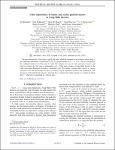Color dependence of tensor and scalar glueball masses in Yang-Mills theories
| dc.contributor.author | Bennett, E | |
| dc.contributor.author | Holligan, J | |
| dc.contributor.author | Hong, DK | |
| dc.contributor.author | Lee, J-W | |
| dc.contributor.author | Lin, C-JD | |
| dc.contributor.author | Lucini, B | |
| dc.contributor.author | Piai, M | |
| dc.contributor.author | Vadacchino, D | |
| dc.date.accessioned | 2023-08-15T08:54:04Z | |
| dc.date.available | 2023-08-15T08:54:04Z | |
| dc.date.issued | 2020 | |
| dc.identifier.issn | 2470-0010 | |
| dc.identifier.issn | 2470-0029 | |
| dc.identifier.other | 011501 | |
| dc.identifier.uri | https://pearl.plymouth.ac.uk/handle/10026.1/21227 | |
| dc.description.abstract |
We report the masses of the lightest spin-0 and spin-2 glueballs obtained in an extensive lattice study of the continuum and infinite volume limits of SpðNcÞ gauge theories for Nc ¼ 2, 4, 6, 8. We also extrapolate the combined results toward the large-Nc limit. We compute the ratio of scalar and tensor masses, and observe evidence that this ratio is independent of Nc. Other lattice studies of Yang-Mills theories at the same space-time dimension provide a compatible ratio. We further compare these results to various analytical ones and discuss them in view of symmetry-based arguments related to the breaking of scale invariance in the underlying dynamics, showing that a constant ratio might emerge in a scenario in which the 0þþ glueball is interpreted as a dilaton state. | |
| dc.format.extent | 011501- | |
| dc.language | en | |
| dc.publisher | American Physical Society (APS) | |
| dc.subject | 5106 Nuclear and Plasma Physics | |
| dc.subject | 5107 Particle and High Energy Physics | |
| dc.subject | 4902 Mathematical Physics | |
| dc.subject | 49 Mathematical Sciences | |
| dc.subject | 51 Physical Sciences | |
| dc.title | Color dependence of tensor and scalar glueball masses in Yang-Mills theories | |
| dc.type | journal-article | |
| dc.type | Article | |
| plymouth.issue | 1 | |
| plymouth.volume | 102 | |
| plymouth.publication-status | Published online | |
| plymouth.journal | Physical Review D | |
| dc.identifier.doi | 10.1103/physrevd.102.011501 | |
| plymouth.organisational-group | |Plymouth | |
| plymouth.organisational-group | |Plymouth|Faculty of Science and Engineering | |
| plymouth.organisational-group | |Plymouth|Faculty of Science and Engineering|School of Engineering, Computing and Mathematics | |
| plymouth.organisational-group | |Plymouth|REF 2021 Researchers by UoA | |
| plymouth.organisational-group | |Plymouth|Users by role | |
| plymouth.organisational-group | |Plymouth|Users by role|Academics | |
| plymouth.organisational-group | |Plymouth|REF 2021 Researchers by UoA|UoA10 Mathematical Sciences | |
| plymouth.organisational-group | |Plymouth|REF 2021 Researchers by UoA|ZZZ Extended UoA 10 - Mathematical Sciences | |
| dcterms.dateAccepted | 2020-07-08 | |
| dc.date.updated | 2023-08-15T08:53:59Z | |
| dc.rights.embargodate | 2023-8-16 | |
| dc.identifier.eissn | 2470-0029 | |
| dc.rights.embargoperiod | forever | |
| rioxxterms.versionofrecord | 10.1103/physrevd.102.011501 |


